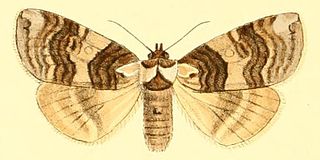| Habrona brunnea | |
|---|---|
| Scientific classification | |
| Kingdom: | Animalia |
| Phylum: | Arthropoda |
| Class: | Insecta |
| Order: | Lepidoptera |
| Family: | Drepanidae |
| Genus: | Habrona |
| Species: | H. brunnea |
| Binomial name | |
| Habrona brunnea Bethune-Baker, 1908 | |
| Synonyms | |
| |
Habrona brunnea is a moth in the Drepanidae family. [1] It is found in New Guinea and on the Moluccas. The habitat consists of mountainous areas. [2]

Moths comprise a group of insects related to butterflies, belonging to the order Lepidoptera. Most lepidopterans are moths, and there are thought to be approximately 160,000 species of moth, many of which have yet to be described. Most species of moth are nocturnal, but there are also crepuscular and diurnal species.

The Drepanidae is a family of moths with about 660 species described worldwide. They are generally divided in three subfamilies which share the same type of hearing organ. Thyatirinae, previously often placed in their own family, bear a superficial resemblance to Noctuidae. Many species in the Drepanid family have a distinctively hook-shaped apex to the forewing, leading to their common name of hook-tips.

New Guinea is a large island separated by a shallow sea from the rest of the Australian continent. It is the world's second-largest island, after Greenland, covering a land area of 785,753 km2 (303,381 sq mi), and the largest wholly or partly within the Southern Hemisphere and Oceania.
The wingspan is 50–54 mm. The forewings are rich sepia-brown, with a pale chestnut basal line strongly angled in the fold. There is a trace of a very short similar line at the extreme base, a trace of twin dark median lines somewhat angled outwardly and a series of four finely waved outwardly angled postmedian lines. There is also a paler brown wedge-shaped apical patch and a pale chestnut or creamy patch at the tornus, intersected with a tridentate short dash. The termen has paler darkly edged dashes and there are two dark spots in the cells. The hindwings are ochreous grey and pale at the base. [3]

The wingspan of a bird or an airplane is the distance from one wingtip to the other wingtip. For example, the Boeing 777-200 has a wingspan of 60.93 metres, and a wandering albatross caught in 1965 had a wingspan of 3.63 metres, the official record for a living bird. The term wingspan, more technically extent, is also used for other winged animals such as pterosaurs, bats, insects, etc., and other fixed-wing aircraft such as ornithopters. In humans, the term wingspan also refers to the arm span, which is distance between the length from one end of an individual's arms to the other when raised parallel to the ground at shoulder height at a 90º angle. Former professional basketball player Manute Bol stands at 7 ft 7 in (2.31 m) and owns one of the largest wingspans at 8 ft 6 in (2.59 m).

